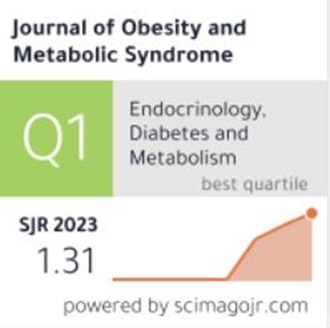Triglyceride–Glucose Index Predicts Cardiovascular Outcome in Metabolically Unhealthy Obese Population: A Nationwide Population-Based Cohort Study
IF 4.7
Q1 ENDOCRINOLOGY & METABOLISM
引用次数: 3
Abstract
Background This study assesses the prognostic value of the triglyceride–glucose (TyG) index for cardiovascular (CV) risk in subgroups based on metabolic health and obesity status. Methods Originally, 514,866 participants were enrolled from the Korean National Health Insurance Service-National Health Screening Cohort. The study participants were categorized into four groups: metabolically healthy non-obese (MHNO), metabolically unhealthy non-obese (MUNO), metabolically healthy obese (MHO), and metabolically unhealthy obese (MUO). The TyG index was calculated using the following formula: ln (fasting triglyceride [mg/dL]×fasting plasma glucose [mg/dL]/2). Participants were followed from 2009 to 2015 for CV events and CV mortality according to the TyG index. Results After exclusions, the final study cohort contained 292,206 people. During the follow-up, 9,138 CV events and 1,163 CV deaths were documented. When the high and low TyG groups were compared, the high TyG group had a substantially increased risk of CV events among the MUNO and MUO participants (multivariable-adjusted hazard ratio [HR], 1.18; 95% confidence interval [CI], 1.07–1.30 and 1.27 [1.14–1.42], respectively). In participants with MUO status, CV mortality was also significantly increased in the high TyG group compared with the corresponding low TyG group (multivariable-adjusted HR, 1.48; 95% CI, 1.13–1.93). In contrast, a high TyG index was not related to CV mortality in the MHNO, MHO, and MUNO groups. Conclusion The predictive value of the TyG index can vary across populations. Among MUO participants, the TyG index was significantly and positively correlated with unfavorable CV outcomes.甘油三酯-葡萄糖指数预测代谢不健康肥胖人群心血管结局:一项全国性人群队列研究
本研究评估了基于代谢健康和肥胖状况的亚组中甘油三酯-葡萄糖(TyG)指数对心血管(CV)风险的预后价值。方法最初,从韩国国民健康保险服务-国民健康筛查队列中招募了514,866名参与者。研究参与者被分为四组:代谢健康的非肥胖(MHNO)、代谢不健康的非肥胖(MUNO)、代谢健康的肥胖(MHO)和代谢不健康的肥胖(MUO)。TyG指数计算公式如下:ln(空腹甘油三酯[mg/dL]×fasting血浆葡萄糖[mg/dL]/2)。根据TyG指数,从2009年到2015年随访参与者的CV事件和CV死亡率。排除后,最终的研究队列包含292206人。在随访期间,记录了9138例CV事件和1163例CV死亡。当比较高、低TyG组时,高TyG组在MUNO和MUO参与者中CV事件的风险显著增加(多变量校正风险比[HR], 1.18;95%置信区间[CI]分别为1.07-1.30和1.27[1.14-1.42])。在MUO状态的参与者中,高TyG组的CV死亡率也显著高于相应的低TyG组(多变量校正HR, 1.48;95% ci, 1.13-1.93)。相反,高TyG指数与MHNO、MHO和MUNO组的CV死亡率无关。结论TyG指数在不同人群中具有不同的预测价值。在MUO参与者中,TyG指数与不利的CV结果显著正相关。
本文章由计算机程序翻译,如有差异,请以英文原文为准。
求助全文
约1分钟内获得全文
求助全文
来源期刊

Journal of Obesity & Metabolic Syndrome
ENDOCRINOLOGY & METABOLISM-
CiteScore
8.30
自引率
9.60%
发文量
39
审稿时长
19 weeks
期刊介绍:
The journal was launched in 1992 and diverse studies on obesity have been published under the title of Journal of Korean Society for the Study of Obesity until 2004. Since 2017, volume 26, the title is now the Journal of Obesity & Metabolic Syndrome (pISSN 2508-6235, eISSN 2508-7576). The journal is published quarterly on March 30th, June 30th, September 30th and December 30th. The official title of the journal is now "Journal of Obesity & Metabolic Syndrome" and the abbreviated title is "J Obes Metab Syndr". Index words from medical subject headings (MeSH) list of Index Medicus are included in each article to facilitate article search. Some or all of the articles of this journal are included in the index of PubMed, PubMed Central, Scopus, Embase, DOAJ, Ebsco, KCI, KoreaMed, KoMCI, Science Central, Crossref Metadata Search, Google Scholar, and Emerging Sources Citation Index (ESCI).
 求助内容:
求助内容: 应助结果提醒方式:
应助结果提醒方式:


